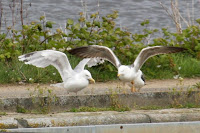Had the pleasure of Richard B's company for the first time in many years on Monday. He was up in Edinburgh and stayed over, so we had arranged a late afternoon and early evening jaunt - we could catch up, and the plan was that he could catch up on a few species that are difficult to see in Fen country. Oak woodland and mountain/moorland specialists seemed a good target, along with whatever goodies might be sprinkled along the coast. Of course, we hadn't factored in an 80-100 mile per hour south-westerly!
With such a gale blowing, the oak woodland was best avoided. There were enough leaves, branches and and even whole trees crashing into the roadsides to warn us that the chances of picking up singing
Redstart,
Pied Flycatcher or
Wood Warbler were less than zero. An attempt to kick off with a yankee duck at Portobello and Musselburgh failed miserably. The sea was being whipped into a hissing surf and the scoter flock, with its male
Surf Scoter, was nowhere to be seen. A red
Red Knot and a
Sanderling on the lagoons were nice compensation though, and after an hour of birdless involuntary sandblasting we were simply glad to be watching anything as we cowered in the bunkers.
We decided to head for the hills after all - a gale wouldn't have any effect on the mountain avifauna after all, would it?... We drove on past Gifford up on to the tops of the Lammermuirs. When trying to locate
Ring Ouzel, having to move by walking at an angle of 30 degrees to the ground when facing into the wind or by taking Neil Armstrong-like bounds when travelling in the opposite direction is not ideal. Despite the extreme conditions we did manage
Dipper,
Red Grouse and
Snipe.
With a feeling that we had seen everything that was foolish enough to show itself in the conditions we headed back to Edinburgh only to be stopped in our tracks by this warning.
Either Banksy or a Banksy-a-like had attempted to warn us of the terrible conditions up on the moors, but it certainly was windy enough for a cow to have to deploy its emergency chute.
We were a little confused by this one though...
Just to let you know that we did see some birds, here is a cracking view of a
Red Grouse.
And, Richard, just for you, the
Surf Scoter in with the
Velvet Scoter flock - what a difference a day makes!
Here is a shot from Monterey, California, to give an idea of what it would have looked like had I remembered my scope...























































